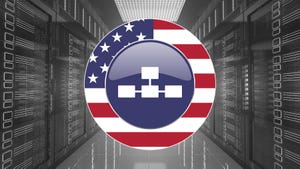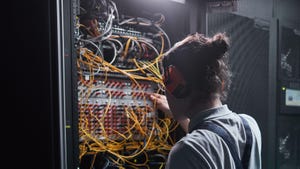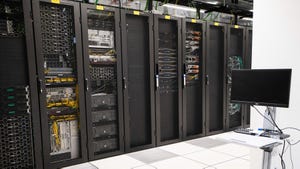
Insight and analysis on the data center space from industry thought leaders.
With the Chip War Raging, Data Centers Must Take NoteWith the Chip War Raging, Data Centers Must Take Note
As chip restrictions increase, data centers must ensure full visibility into their components to stay compliant and secure, writes Oshri Cohen.
Data center owners face a growing challenge. As geopolitical tensions escalate over the ‘chip war,’ new tariffs and restrictions loom, and supply chain pathways become more complex, ensuring electronic component sourcing’s clarity and reliability has never been more difficult.
As a result, data center operators require greater visibility into the systems they install than ever before – down to the last component. They must ensure their systems contain only approved components and have precise knowledge of component origins to comply with strict economic and national security policies.
To stay compliant with these ongoing and expected regulations, data center owners can no longer rely solely on bills of materials, which are not always accurate or reliable. Fortunately, visual AI technologies can ensure that every component is inspected, logged, and tracked – and can be traced with forensic accuracy down to its manufacturer and country of origin.
As AI’s growth drives a relentless demand for data centers, leading to a nearly 50% rise in data center capital expenditures in 2024, these hubs’ continuous operation and compliance are critical. Under the incoming Trump administration, which has pledged to invest billions in the industry, U.S.-based companies are poised to increase their AI infrastructure further and go the extra mile to ensure they are aligned and compliant with the America-centric approach to innovation.
The Beating Heart of Data Centers
Building the seamless and compliant data centers of the future starts with servers, which run on printed circuit boards (PCBAs). These boards are composed of and powered by an array of electronic components – from expensive and complex processors to tiny resistors, transistors, and capacitors – that are sourced worldwide.
Unfortunately, while data center operators have complete control over the systems they install, they have little control or visibility into the origin of the components that beat at the heart of those systems. And herein lies one of the most impactful and often overlooked risks.
Just like in the poem about the kingdom lost “for want of a nail,” the impact of a threat often far outweighs its physical size. A single damaged, counterfeit, or maliciously placed faulty capacitor – just 1 square mm, costing mere cents – can render an entire PCBA and an entire system completely inoperable.
Without deep visibility into every component, data center system manufacturers cannot ensure full cyber-physical security for their buyers, the data center operators. And those operators must recognize that their risks extend far beyond traditional quality assurance or cybersecurity.
A Rising Tide of Restrictions
As the U.S. continues to encourage the transition away from dependence on semiconductors and minerals originating from China, technology that provides visibility into the origin of individual components and any flaws or age defects therein, is all the more critical.
At the start of the second Trump administration, the onshoring of data center operations to the U.S. led to tariffs as high as 50% on Chinese semiconductors. In retaliation for a slew of economic restrictions and among many initiatives, China has planned to ban exports of materials and metals such as gallium, antimony and germanium – crucial components for producing semiconductors. The U.S., in turn, has added 140 new Chinese companies to the “Entity List” of sanctioned organizations that U.S. companies are not permitted to do business with.
Technologies that provide full transparency into component origins are crucial for data centers to thrive and will become data centers’ primary means of remaining compliant with regulations around country-of-origin, preventing the use of unauthorized components, and identifying any evidence of dangerous tampering.
The Right Tools for the Job
One way for data centers to confidently navigate these tit-for-tat measures and meet these regulatory and security needs is by leveraging tools such as visual AI and AI-driven data analytics that are designed to identify component authenticity, track suppliers, and flag anomalies on both the component and PCBA levels that could lead to regulatory or security risks.
This type of automated security control not only helps mitigate the dangers of faulty, counterfeit, non-approved, or low-quality electronic components from being placed on boards, but also ensures that the components are coming from exactly where they say they are and haven’t been tampered with.
Traditionally, OEMs had to rely on their own design plans or the setup reports provided by their contract manufacturer to understand the makeup and origins of the components on their boards. Unfortunately, these reports are often prone to human error and do not always accurately represent the origin, integrity, and security of the components placed on every individual PCBA.
The advent of visual AI tools has helped to bridge this gap, giving manufacturers the ability to minimize manual inaccuracies and enhance operations. These tools capture images on both the bottom and top sides of every component to detect body defects or bent leads and can recognize the signs that point to non-compliance or malicious intervention.
Critically, these solutions can also capture all the identifying information for any component as it’s being placed on the PCBA to ensure maximum traceability down to the individual component level. This results in 100% accurate traceability data and alleviates the need to rely on “theoretical” bill of material lists.
Data center owners and systems manufacturers must demand that these technologies are implemented. To power the next generation of secure, compliant data centers, real-time alerts for suspicious components during the assembly process, forensic reports for every PCBA, and detailed “rap sheets” for every board must become the norm.
Conclusion
Empowering data center operators and manufacturers with the tools that enable them to understand with forensic detail what is going into their data centers is a crucial step forward. Indeed, it is critical that data centers, which rely on semiconductors and PCBAs, can keenly understand – and even guarantee – where the materials and components they run on come from.
With uncertain trade regulations looming, knowing exactly what is inside a data center isn’t just a “nice to have” feature – it’s the difference between a more stable supply chain that supports proper working and compliant systems, and a chip-wreck disaster.
About the Authors
You May Also Like











